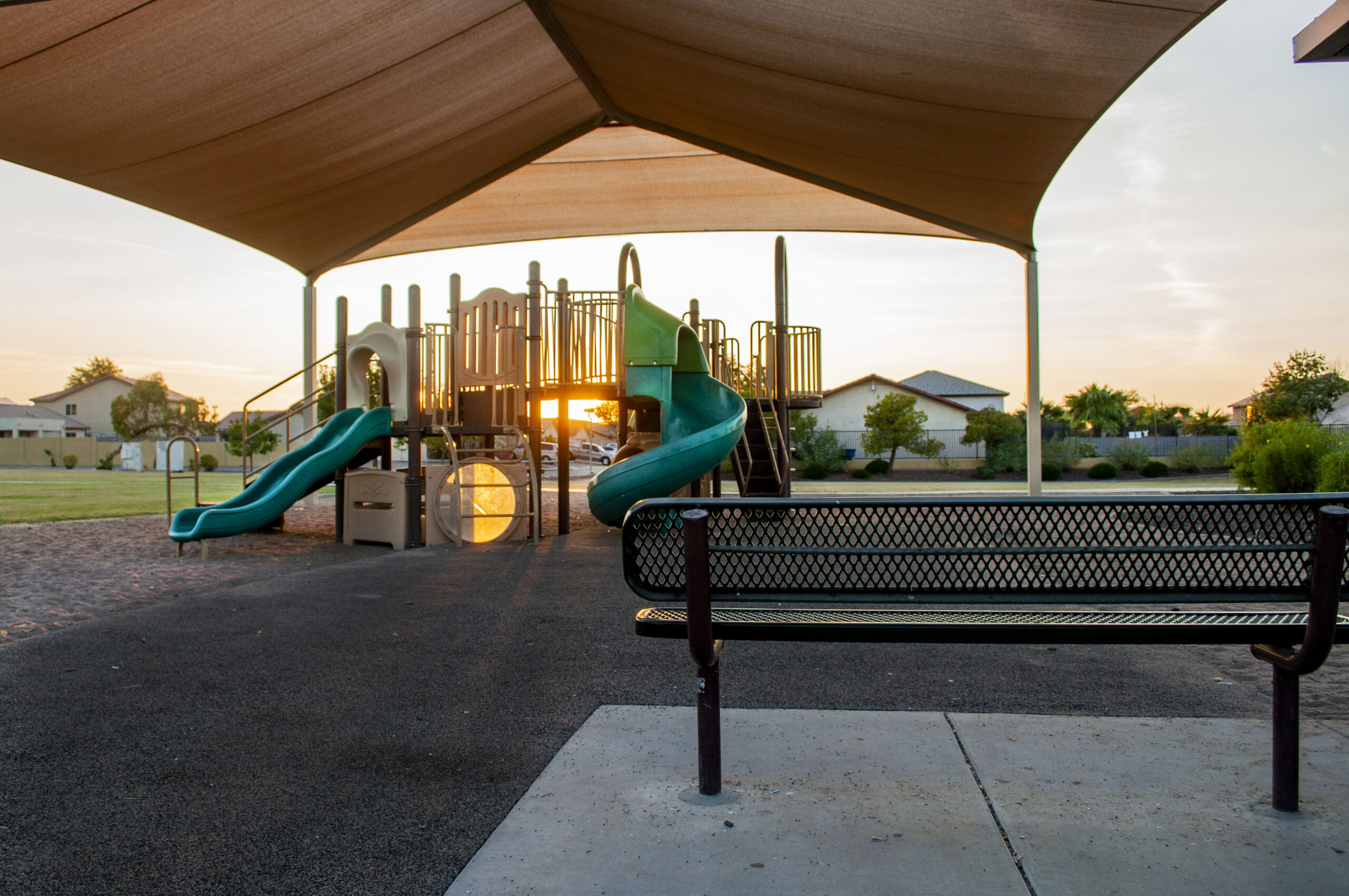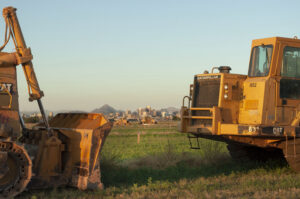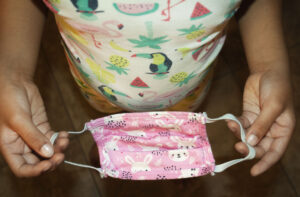
“Dope Bag Park.” Photograph by Maria Nancy Thomas
Thank God for the sun. Its excessive heat has forced the ants, flies, and cockroaches to retreat under the electric boxes planted around the neighborhood jungle gym I call “Dope Bag Park.” (It gets its name because frequently I’ll see cellphones glow and lighters flicker under the slide as dope dealers and smokers lounge, disguised by the night; come dawn, little plastic bags holding on to the faint smell of weed will remain, blowing onto my front doorstep.) Although insects are no longer a nuisance in the Arizona heat, the novel coronavirus and the racism pandemic have turned American life feral.
I’m a freelance writer who lives in the historically Black and Brown community of South Phoenix. After a long day covering the inequities of over-policing Black communities and the overuse of force against Black people, I watch the sun finally set on the desert horizon facing my office window. I cannot make out the houses on South Mountain because a lethal industrial and waste facility and highway pollution have erased them from view.
Suddenly the neighborhood app repeatedly beeps, alerting me to gunshots in the surrounding area. It’s a routine summer night here in the Wild West, where gangs, graffiti artists, sex workers, and thieves set the 100-plus-degree nights ablaze.
I hear the gunshots themselves, too, cracking as they penetrate the air. Red, white, and blue flashes illuminate the housing projects, two city blocks away. Sirens and ghetto birds are part of the city’s soundtrack. In the morning, news websites report the body counts from yesterday’s COVID-19 data, protests, police violence, and overnight street battles.
In Arizona, the stay-at-home executive order lasted only about three weeks until white conservatives decided that the Republican governor, Doug Ducey, had held them and their “right to work” hostage long enough. Their actions catapulted Arizona to one of the top five COVID-19 hot spots in the United States over the summer, alongside more populous states such as California, Florida, and Texas.
But even before Gov. Ducey signed the stay-at-home executive order, my wife and I decided to keep our daughters, who are Afro-Mexican—Jade, age 5, and Naimah, who will turn 2 in November—from the public. There was no evidence that children were less susceptible to contracting COVID-19, and we did not want to risk their health.
On the day the mayor of Phoenix made it mandatory to wear masks in June, I went to a gas station and witnessed two customers shouting at each other in a crowded shop:
Customer 1: “Why aren’t you wearing a mask?”
Customer 2: “Why are you walking the store with a backpack—going to steal something?”
Customer 1: “No, but they should check your pockets! Hey, yo, check her pockets!”
Customer 3: “He is so rude.”
Customer 2: “I know.”
The exchange confirmed my suspicion that there is no need to risk bringing my girls out where COVID-19 has exacerbated already existing tensions.
My anxiety and depression, which usually govern my daily life, have taken on new life in this COVID-19 hellscape.
As a husband and father, I feel helpless, unable to promise my wife and daughters safety from these dangers. As a service-connected disabled veteran with PTSD, it especially hard not to feel inundated with news and conversations about unarmed Black or Brown men, women, and children fatally shot by law enforcement.
Racial disparities mean that both COVID-19 and unemployment are disproportionately deadly to Black people, as are police-involved shootings.
One in 920 Black Americans have died of the virus, twice the rate of white Americans. Black folks also experience America’s highest unemployment rate, at 12.6 percent. And Arizona remains in the top five states for police-involved shootings; its rate of people shot by the police is 39 per million.
We live in South Phoenix’s 85041 zip code, a historically low- to middle-income community that remains a hotspot for COVID-19. Cases here are more than triple the per-capita cases in more affluent neighborhoods such as Scottsdale.

At 27th Ave & Southern Ave, where new homes are going to be built soon. Photograph by Maria Nancy Thomas
During the Segregation Era prior to the 1960s, the city of Phoenix designated South Phoenix as “hazardous land.” But today, the city government is selling this “hazardous land” to developers, along with significant tax breaks. Each new shopping complex and gated community built in our neighborhoods drives home values, rents, and property taxes higher. This rapid inflation is forcing families from the neighborhoods where they have lived in for generations.
On Sunday, April 19, 2020, I woke up to a report in the Detroit News about a 5-year-old girl named Skylar Herbert who developed a rare complication from coronavirus and became the first child from Michigan to die of the disease.
As I read the article, Jade’s face flashed through my mind. Then I thought of Aiyana Mo’Nay Stanley-Jones.
Aiyana, a 7-year-old Black girl sleeping on her grandmother’s couch, was shot and killed by a Detroit SWAT team as the crew of an A&E true-crime reality TV show, The First 48, filmed. Police kicked in her grandmother’s apartment door, threw in a flash-bang grenade, and lit her blanket on fire. Then Officer Joseph Weekley fired a single shot that drilled through her head and out of her neck.
America has already added Skylar and Ayiana to its kill rate. Jade is in its crosshairs.
In the first week of July, we finally purchased a mask for Jade. Because the Centers for Disease Control and Prevention recommend that children younger than 24 months not wear protective masks due to potential breathing issues, we have not had Naimah wear a mask, but we get mean side-eyes when people in public notice.

Jade holding her first mask. Photograph by Maria Nancy Thomas
We have talked to Jade about the pandemic, and she is very conscious of social distancing and the importance of wearing a mask in public. She also knows she won’t be able to go to school with her friends until the spread COVID-19 slows. Because I work from home, I am blessed to be able to care for my daughters during this time. My wife, Nancy, and I do not have to bear the added stress of finding daycare as many working parents do.
The girls’ smiles keep our spirits up amidst the ongoing social chaos.
Jade has adapted. Her friend, Z, lives next door, and lately his head appears above the 6-foot-high brick wall dividing his family’s back yard from ours. Both he and Jade have a ladder, and they take turns: Z sits on his ladder while Jade stands on the ground, or vice versa. It is their form of social distancing.
It is normal for my daughters and I stay inside our house to escape outside’s devilish heat, but this summer we added another step to our plan and constructed forts to protect ourselves from COVID-19. When Nancy returns home from her job as an operations manager at a fine arts installation company, the day is beginning to cool into the evening, and we can finally go outside. The Arizona sun and heat are harsh on our skin. Both my daughters have light brown skin. In less than ten minutes, they turn pinkish-red, even with sunscreen.
Lately, when I wake up, my heart swells, pushing against my chest. I wonder: “How can I avoid dying by the hands of the police or COVID-19?”
I am a member of one high-risk group because I live with genetic chronic hypertension and must avoid COVID-19’s potentially fatal symptoms. My body and mind fight each other. Mostly, I can’t sleep. Sometimes, I can’t eat. When I am able to eat, my internal organs are lethargic and the food moves too slowly. Every day, I feel uneasy.
I am scared to be a Black father who is genetically vulnerable to the novel coronavirus and socially vulnerable to the racism pandemic. My fear holds me hostage. But my fear is also a tool that keeps me vigilant. It feeds my physical and mental energy to fight for my daughters, for my family, and for my community’s right to the pursuit of life, liberty, and happiness.
When friends and family ask me how I am, I answer, “My wife and daughters are healthy and happy. That is all that matters.”




Send A Letter To the Editors